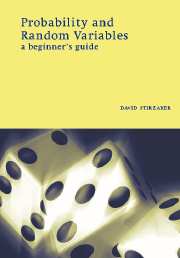Book contents
Review of Part A, and preview of Part B
Published online by Cambridge University Press: 05 June 2012
Summary
I have yet to see a problem, however complicated, which, when you looked at it in the right way, did not become still more complicated.
P. Anderson, New Scientist, 1969We began by discussing several intuitive and empirical notions of probability, and how we experience it. Then we defined a mathematical theory of probability using the framework of experiments, outcomes, and events. This included the ideas of independence and conditioning. Finally, we considered many examples in which the outcomes were numerical, and this led to the extremely important idea of probability distributions on the line and in higher dimensions. We also introduced the ideas of mean and variance, and went on to look at probability density. All this relied essentially on our definition of probability, which proved extremely effective at tackling these simple problems and ideas.
Now that we have gained experience and insight at this elementary level, it is time to turn to more general and perhaps more complicated questions of practical importance. These often require us to deal with several random quantities together, and in more technically demanding ways. It is also desirable to have a unified structure, in which probability distributions and densities can be treated together.
For all these reasons, we now introduce the ideas and methods of random variables, which greatly aid us in the solution of problems that cannot easily be tackled using the naive machinery of Part A.
- Type
- Chapter
- Information
- Probability and Random VariablesA Beginner's Guide, pp. 185 - 186Publisher: Cambridge University PressPrint publication year: 1999



